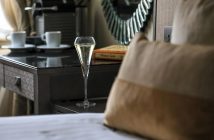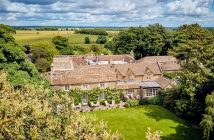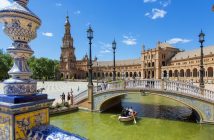Originally opened in 1865 by a Parisian merchant fleeing bankruptcy, Daniel Nicholas Thévenon changed his name to Daniel Nicols and established Café Royal with his wife Celestine, a restaurant inspired by the grand brasseries of his native Paris. Located in the heart of London’s buzzing theatre district, by the end of the century and the assistance of their astute son-in-law, Café Royal became one of the most glittering places to be seen, with a clientèle list as endless as the vintages housed in wine cellars that were then claimed to be the most impressive in the world, with Winston Churchill, Arthur Conan Doyle, Oscar Wilde and Virginia Woolf among the regular diners who enjoyed the fun-filled atmosphere which offered a corner of French opulence on otherwise gloomy days in the city.
Fast forward a hundred and forty years, however, and unlike so many London haunts which successfully trade on their former esteemed patronage, Café Royal was forced to accept its fall from grace and the fact that it had long since been abandoned as the playground of the rich and famous, and closed its doors in 2008 like an out-played opera, with all non-Grade listed fittings and fixtures sold at auction. But this was far from the end of Café Royal. As part of the Crown Estate’s plans to redevelop the southern end of Regent Street, the property was acquired by The Set who commissioned David Chipperfield Architects to direct what turned out to be a four-year and multi-million pound renovation and redesign project, with the result that not only was the Café itself reinvented, but with the startling addition of a 160-room luxury hotel, including 49 suites and six signature suites, all in a contemporary style quite distinct from the historic public rooms, which were in turn painstakingly restored to their original glory.

Our elegant, masculine-looking junior suite overlooked the bustling Regent Street and, taking inspiration from the Portland stone with which the street was originally built, featured striking stone walls which had the tendency of making you feel like you’d been incarcerated in a rather swanky cell – a theme which seemed to flow through into the imposing Carrara marble bathroom, equipped with a flat screen television and my favourite Floris toiletries. This space was distinctly rock ‘n’ roll – sexy and sophisticated without being cosy or charming, and featured a spacious open-plan lounge and workspace, not to mention an enormous wardrobe crafted from fumed English oak, and with prices starting from £810 per night (the Oscar Wilde Suite starts from £2,195) is sure to entice not only the wealthiest, but the most fashionable visitors to London, with cutting edge design that oozes quality and a bravery adopted by only the most confident architect and designers.
Residents are offered a separate entrance to The Akasha Spa, now regarded as one of the finest in the capital and equipped with a 60ft long swimming pool and a state-of-the-art gymnasium. Guests staying in a junior suite (or upwards) also have access to the members only Club occupying the first floor which promotes regular art exhibitions by way of generating ever-changing and amusing conversation pieces, and with the intention of reviving the bohemian atmosphere the Café was once notorious for. The new Green Bar has meanwhile taken inspiration from The Café Royal Cocktail Book of 1937 and the revival of Absinthe, a tipple notorious for being favoured by the intellectuals of the nineteenth and early twentieth century. Featuring shiny green glass walls, a neon light above the bar and Absinthe fountains, sample one of the eight Givenchy cocktails specially created by bar manager and mixologist, Antonio Catapano.

Each new space sits alongside its original counterparts surprisingly well; a mishmash of old and new architecture and design, just like the city itself, that is testament to the harmonious marriage that can exist between modernity and tradition – begging the question, is the new Café Royal a hotel or a work of art? Step through the original revolving doors and you’ll still find the name of Nichols inscribed in the characteristic marble foyer, with a door just opposite leading to the former Grill Room, now renamed the Oscar Wilde Bar, which has been immaculately restored with its distinctive red leather upholstery, ornate Louis XVI gilding and mirrors, and where I found a handful of tourists enjoying the secluded and womb-like atmosphere for a leisurely London Royal Tea, a witty take on the English ritual. On selected evenings the space becomes the Black Cat Cabaret, something I’m sure Wilde, who reportedly fell in love with Lord Alfred Douglas in this very room, would have approved of.
Meanwhile the Café is now just that; no longer an expensive brasserie serving the great and the good, but a smart-looking Parisian-style patisserie lined with golden Siena marble walls and exquisitely crafted cabinets filled with tempting cakes and bakery items. With its own entrance on Regent Street, the informal Café doubles as a meeting place for visitors and locals alike, and the windows, which remind one of a Fortnum and Mason display, succeed in enticing passers by to purchase the Café’s range of branded goods as a souvenir of one of London’s reborn landmarks.

It’s a fascinating example of what a modern luxury hotel can be when it is created with no expense spared, yet the added bonus of having some very familiar and historic foundations at its heart. Whether guests choose to spend their time dining in one of the restaurants they can opt for either modern or traditional fare, sip cocktails at one of the bars (historic or new), or take afternoon tea as casually or elaborately as they like. The Ten Room, currently under the command of chef de cuisine, Armand Sablon, is currently the hub of the hotel, due to being the setting for breakfast, lunch and dinner, with The Domino restaurant still awaiting a new head chef to lead what will become the hotel’s much anticipated fine-dining experience.
With so many unique spaces and options available to guests, the hotel never feels particularly busy, and therefore manages to create a surprisingly relaxing ambiance despite being located on one of London’s busiest shopping streets. I thought, before my stay, that I knew what to expect, but I was wrong; whilst it was once a place for traditionalists, the old haunts are more like museum exhibits that are almost entirely overshadowed by the vibrant new areas. It doesn’t just live up to it’s celebrated past, it undoubtedly exceeds it. Move over 19th century.
Hotel Café Royal, 68 Regent Street, London W1B 4DY London. Superior guest-rooms start from £440 per night. For more information and reservations visit the website.




